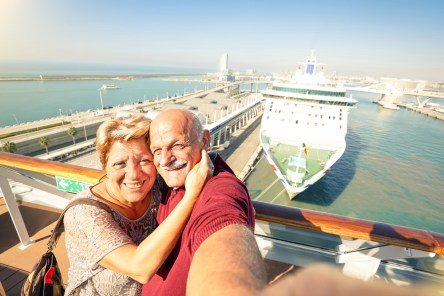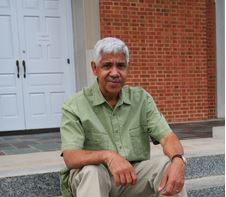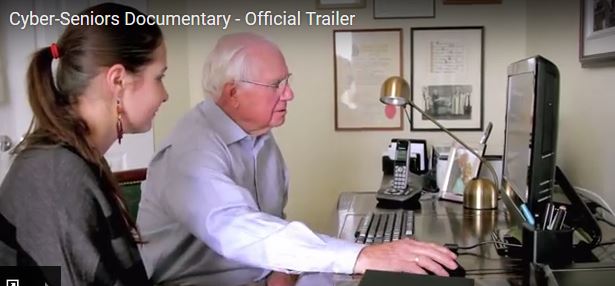With new holidays and observances cropping up all the time, can be hard to keep track. But there’s one upcoming celebration not to be missed: Senior Citizens’ Day, marked each year on August 21. While thinking of ways to honor the special seniors in your life, let’s recall the origin of this important observance. It began with a proclamation by Ronald Reagan on August 19, 1988. Our former President lauded the achievements of our nation’s elders, thanked them for their leadership, and highlighted the ways in which older people, living longer and fuller lives than ever, continue to make their presence felt for their own good, and that of others. As we consider all the seniors we know and what they’ve contributed to our lives and to our society, it’s important to think about what we can give back. The Senior Citizens’ Day proclamation addressed this too: We can best demonstrate our gratitude and esteem by making sure that our communities are good places in which to mature and grow older— places in which older people can participate to the fullest and can find the encouragement, acceptance, assistance and services they need to continue to lead lives of independence and dignity. The words proclaimed decades ago still hold true. The most important way we can repay those who came before us is to ensure they’re well taken care of in the communities in which they now reside. How much progress have we made in the thirty years that have passed since these words were penned? While we still have opportunities to better the senior living industry, today’s seniors have more choices for quality care than ever before. From luxury independent living to high-tech, patient-focused care regimens, residents are no longer resigned to just a...
Seniors Set Sail
Retirement Options
For some retirees, living out the golden years at sea provides a fun, and surprisingly affordable, alternative to typical senior living facilities. While many aging adults anticipate retirement to be one endless vacation, some savvy seniors are taking that vacation mentality to the next level by making their home onboard a cruise ship. In many cases, this choice not only allows retirees to see the world but provides them access to many of the same amenities available at most reasonably-priced retirement communities, at just about the same cost. “What easily grabs your imagination when you think about people who opt to live aboard cruise ships instead of in retirement communities is how much fun it must be to be out in the world, meeting new people and seeing new places in a lovely atmosphere with good food and attentive service,” says Spencer Brown, Carolyn Spencer Brown, editor in chief of CruiseCritic.com. Affordable Adventures “You can go on a world cruise for under $300 a day, per person, double-occupancy,” Mara Hargarther, a travel agent and cruise vacation specialist at Dream Vacations in Ponte Vedra, Fla, recently told The New York Times. Explaining how those fees are often only slightly higher than high-end senior living facilities. In fact, according to a 2004 study from the Journal of American Geriatrics Society, 20 years on a cruise ship comes with a price tag of just about $230,000, only a little more than the $228,075 cost of living for two decades in a retirement home. Though there’s no doubt the current cost would be much higher, LongTermCare.gov estimates annual fees for assisted living range between $36,000 to $72,000, right in line with an average daily rate of $100 most consumers can expect to pay aboard a cruise ship. The idea...
No More Falls
Senior Safety Technology
For many senior citizens, the choice to move into assisted living begins the moment staying at home becomes dangerous. Tripping over carpet or a tumbling down a flight of stairs can no longer be dispatched with an ice pack or a trip to urgent care. For adults 65 and older, these incidents often result in broken bones, head injuries or even death. But what if a fall could be predicted and prevented? That’s the hope behind a new sensor system developed by the Sinclair School of Nursing and the College of Engineering at the University of Missouri. Through a combination of onsite monitoring and data analysis, the sensors record the gait and speed of residents. That information can then be used to forecast when a fall might be imminent helping care providers take action before calamity. “Assessment of these functions through the use of sensor technology is improving coordinated health care for older adults,” Marjorie Skubic, director of the MU Center for Eldercare and Rehabilitation Technology, tells Engineering.com in a recent interview about the sensor system. Watchers on the Wall The sensor project is part of ongoing research currently underway at TigerPlace, a Missouri retirement community that promotes “aging-in-place.” Part of a collaboration between Americare Corporation and the University of Missouri, TigerPlace’s main objective is to “maximize the independence of residents while supporting research.” The facility has been using the sensors as part of ongoing research to study how early detection of “changes in function” can be used to target health problems before they become critical. As part of that process, the project’s In-home Monitoring System (IMS). IMS wirelessly records and shares motion data and images collected by sensors placed throughout the home. If significant changes in activity are detected, the system can send...
Retirement Benefits
Good for your health
They say you can’t teach an old dog new tricks, but a new study of recently retired Australians proves there’s always time to change your life. Conducted by the University of Sydney, the study tracked more than 25,000 older Australians, recording their general health habits, including physical activity, alcohol use, and sleep patterns. These statistics were then compared to post-retirement behavior, and the results are surprising. Rather than wither on the vine, retirees seemed to find a new lease on life. In fact, many report becoming more active once they transitioned out of the workforce. “Our research revealed that retirement was associated with positive lifestyle choices,” said lead researcher Dr. Melody Ding, Senior Research Fellow at the University of Sydney’s School of Public Health, in a statement about the research. “Compared to people who were still working, retirees had increased physical activity levels, reduced sitting time, were less likely to smoke, and had healthier sleep patterns.” Not only did study participants improve their overall health, but many of the differences were significant, even after adjusting for factors like age, sex, marital status, education, and residency. According to the study, nonworking senior citizens increased physical activity by 93 minutes per week, decreased sedentary time by over an hour per day, and increased sleep by 11 minutes per night. Additionally, over half of all female smokers quit smoking. For participants in the study, the biggest differences appeared among those who’d worked 40-hour weeks. Ding believes ditching commuting and finally abandoning inactive hours behind a desk provide seniors with the chance change their day-to-day lives, making room for more exercise, balanced meals, and better sleep. “The lifestyle changes were most pronounced in people who retire after working full-time,” says Ding. “When people are working and community, it...
Active Retirement
Best U.S. Cities
With its mild weather and low-cost housing, Florida has held the crown for top retirement destination for decades. However, what once intrigued and lured senior citizens to Gulf Coast condominiums and South Beach high rises no longer carries sway. A new era of retirees are changing the notion of “ideal retirement location.” The king has been deposed, and though Pompano Beach and West Palm Beach still maintains some allure, the top spots now include more than a few unlikely candidates. A Different Kind of Retiree SmartAsset recently set out to discover what U.S. cities were best for active retirement. What they found was a shift away from quiet, sedentary twilight years. Instead, today’s seniors want stronger community connections, friendly tax policies, and all the amenities associated with an active lifestyle. With boomers poised to dominate all facets of senior living over the next several decades, the cliché of aimless retirees splitting time between golf and bingo has changed. As a reflection of this shift, SmartAsset chose to study the nation’s top cities based on this new set of metrics. What they found upends some of the most basic assumptions about what makes a perfect golden years retreat. The Active Lifestyle SmartAsset considered four metrics for their study: average effective tax rate, the number of doctors per 1000 residents, the number of retirement centers per 1000 inhabitants, and percentage of population made up by senior citizens. When assessing a city’s active lifestyle compatibility, SmartAsset determined the area’s Walk Score, which measures pedestrian navigability, safety and convenience. They also took into account the number of golf courses per 100,000 residents (some standards still apply!). Another key data point measured the number of other fitness-related businesses, like gyms, recreations centers and sporting goods stores, in the area. Once...
Bridging the Digital Divide
Sienna Senior Living
We live in an increasingly connected society, with unlimited data at our fingertips and the ability to communicate quickly with friends and family living next door or half-way ‘round the world. There’s an ease and level of expectation we take for granted when it comes to bending the latest technology to our will, but for many senior citizens, modern digital tools and gadgets often seem complicated and out of reach. It’s a generational gap the Cyber-Seniors program hopes to bridge through its innovative approach to senior education. For Sienna Senior Living, participating in the program is a natural extension of the company’s commitment to providing its clients with comfort, independence and “the warmth of human connection” through its forward thinking, resident-centered approach to senior care. The brainchild of two teenage sisters inspired by the impact of the Internet on the lives of their own grandparents, Cyber Seniors began in earnest in 2009. Through the program, high school students help seniors develop a technology skill set that allows them to use computers, the internet and other digital tools to connect with friends, family and their community. Over the years, the program has collaborated with the University of Toronto Occupational and Therapy Masters Program and Sienna Senior Living to develop a best practice resource manual to ease implementation of similar programs throughout Canada across all Sienna Senior Living Retirement Residences and Long Term Care Homes. Last year’s pilot projects involved residents at the Cedarvale and Villa Leonardo retirement communities. As Sonia Roul, Recreation and Leisure Consultant for Sienna Senior Living’s Long Term Care Division, explains, the Cyber-Seniors “empowers the residents to go beyond their walls and explore what the world of technology can offer them.” “Our hope was to help our residents connect with their loved ones in a new way,” says Roul, “while also providing them with the opportunity to connect on a human level with a much younger generation.” Refreshed Spirits and Enhanced Health For those involved in the project, the Cyber Seniors program is more than just a computer class; it’s a source of life enrichment for all the participants. By pairing interested retirees with volunteer high school students, the Cyber Seniors program creates a cooperative, mutually rewarding learning environment. The hope is that the program will prompt meaningful, multi-generational conversations and inspire new interests amongst residences in the senior living communities. For Sienna Living, the appeal of the Cyber Seniors program primarily involves the chance to create bonds and build connections between residents and the community. As a source of entertainment and physical and psychological enhancement, the program aims high and hits the mark. As seniors become more comfortable accessing the World Wide Web and using YouTube, Skype and more, they broaden their horizons and connect with the outside world while also building long-lasting friendships. “Breaking down the barriers of communication through learning and development truly does wonder for the residents and students involved,” declares Roul. “The bonds created between the students and the residents were unexpectedly powerful,” Roul explains. “They were able to create connections with past lifestyles, and there was a mutual exploration across natural areas of interest.” The seniors are full of admiration for their teen advisers, dazzled by their ability to navigate the online universe, and heartened by the supportive and encouraging learning environment created by their young instructors. “To see them be so young but know so much is amazing,” explains a Cedarvale resident in a video about the program. For the teens, the benefits of assuming the mantle of Cyber Senior instructor allows them the opportunity to experience leadership roles while also forging intergenerational relationships. “It feels awesome,” declares a teen participant in the video. “It feels like you’re bridging the gap between the past and now.” Broadened Horizons and Deepened Connections In June of 2014, the Sienna Senior Living’s Cedarvale Lodge Retirement and Care Community in Keswick Ontario collaborated with...






